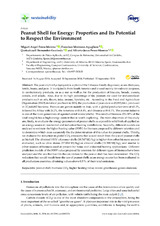Peanut Shell for Energy: Properties and Its Potential to Respect the Environment
Autor
Perea-Moreno, Miguel Ángel
Manzano Agugliaro, Francisco
Hernández-Escobedo, Quetzalcoatl
Perea Moreno, Alberto Jesús
Editor
MDPIFecha
2018Materia
Peanut shellBiomass
CO2
Higher heating value
Waste
Greenhouse gasses emission
METS:
Mostrar el registro METSPREMIS:
Mostrar el registro PREMISMetadatos
Mostrar el registro completo del ítemResumen
The peanut (Arachys hypogaea) is a plant of the Fabaceae family (legumes), as are chickpeas,
lentils, beans, and peas. It is originally from South America and is used mainly for culinary purposes,
in confectionery products, or as a nut as well as for the production of biscuits, breads, sweets,
cereals, and salads. Also, due to its high percentage of fat, peanuts are used for industrialized
products such as oils, flours, inks, creams, lipsticks, etc. According to the Food and Agriculture
Organization (FAO) statistical yearbook in 2016, the production of peanuts was 43,982,066 t, produced
in 27,660,802 hectares. Peanuts are grown mainly in Asia, with a global production rate of 65.3%,
followed by Africa with 26.2%, the Americas with 8.4%, and Oceania with 0.1%. The peanut industry
is one of the main generators of agroindustrial waste (shells). This residual biomass (25–30% of the
total weight) has a high energy content that is worth exploring. The main objectives of this study
are, firstly, to evaluate the energy parameters of peanut shells as a possible solid biofuel applied as
an energy source in residential and industrial heating installations. Secondly, different models are
analysed to estimate the higher heating value (HHV) for biomass proposed by different scientists and
to determine which most accurately fits the determination of this value for peanut shells. Thirdly,
we evaluate the reduction in global CO2 emissions that would result from the use of peanut shells
as biofuel. The obtained HHV of peanut shells (18.547 MJ/kg) is higher than other biomass sources
evaluated, such as olive stones (17.884 MJ/kg) or almond shells (18.200 MJ/kg), and similar to
other sources of biomass used at present for home and industrial heating applications. Different
prediction models of the HHV value proposed by scientists for different types of biomass have been
analysed and the one that best fits the calculation for the peanut shell has been determined. The CO2
reduction that would result from the use of peanut shells as an energy source has been evaluated in
all production countries, obtaining values above 0.5h of their total emissions.

